Some people say that diabetes itself is not terrible, but the complications of diabetes are terrible. Once complications occur, the quality of life of people with diabetes will be greatly reduced, and severe cases may even be life-threatening.
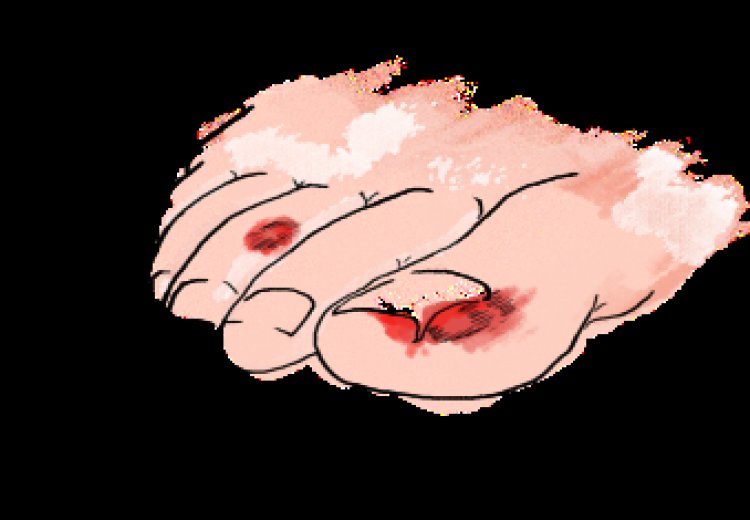
What is Diabetic Foot? What is the cause of the disease? What specific treatments are there? In the “Shanghai Jiading” APP and the Jiading Radio and Television Station’s FM100.3 synchronous audio and video live broadcast program “Healthy Ways”, the guests gave a detailed introduction to relevant popular science knowledge and answered questions raised by some listeners and netizens.
Guest introduction: Suo Lixia, currently the director of the Department of Endocrinology of Jiading District Central Hospital, has been engaged in clinical work of endocrinology for more than 20 years.
What is a diabetic foot?
Diabetic foot is a common chronic complication of diabetes and one of the important causes of death and disability in diabetic patients. Diabetic foot refers to foot infection, ulceration and/or deep tissue destruction caused by distal lower extremity neuropathy and/or peripheral vascular disease of varying degrees in diabetic patients. The relative risk of lower extremity amputation in diabetic patients is 40 times that of non-diabetic patients, and diabetic foot amputations account for more than 50% of non-traumatic amputations each year.
What foot conditions can lead to diabetic foot?
There are various foot deformities and calluses/corns (abnormal distribution of plantar pressure), ingrown nails/returned nails/paronychia, tinea pedis/onychomycosis (onychomycosis), nail extraction, etc. Predisposing diabetic foot, these are high-risk factors for diabetic foot; patients with a history of foot ulcers or foot blisters in the past have a higher risk of recurrence of foot ulcers.
Also, have a brown “pretibial spot” on the front of the calf or have diabetic skin lesions (thinning of the skin on the front of the calf, reduced hair) or other skin conditions, and more severe varicose veins Patients are also prone to skin ulcers.
How are regular preventive checkups for diabetic feet based on their risk stratification?
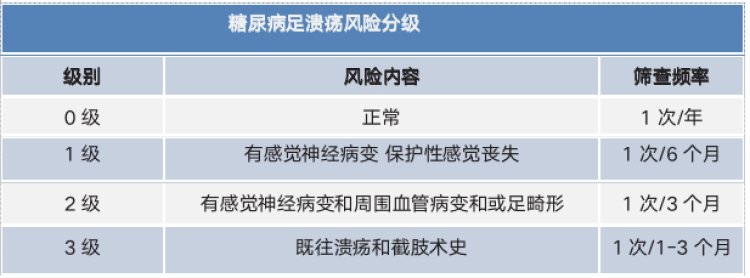
How should diabetic patients self-examine their feet to identify risk factors for diabetic foot?
1) Check your legs, are there brown spots on the front of the shin? Is the skin thinning and hair loss reduced? If you notice any of the above symptoms, see an endocrinologist immediately.
2) Check the feet every day: fully expose the feet in the case of sufficient light, you can use a mirror to observe carefully, or ask your family to help you check. Mainly check the skin of the lower limbs, between the toes and the soles of the feet, observe the skin color, whether it is dry, chapped, whether there is redness, swelling, discoloration (blue, purple, black, white), damage, blisters, calluses, corns, tinea pedis , Whether the toenail is abnormal, whether the toe is deformed, the temperature of the foot changes (cold, fever), the pulse of the foot arteries, etc., if the above conditions are found, immediately go to the endocrinology specialist or podiatric center for medical treatment.
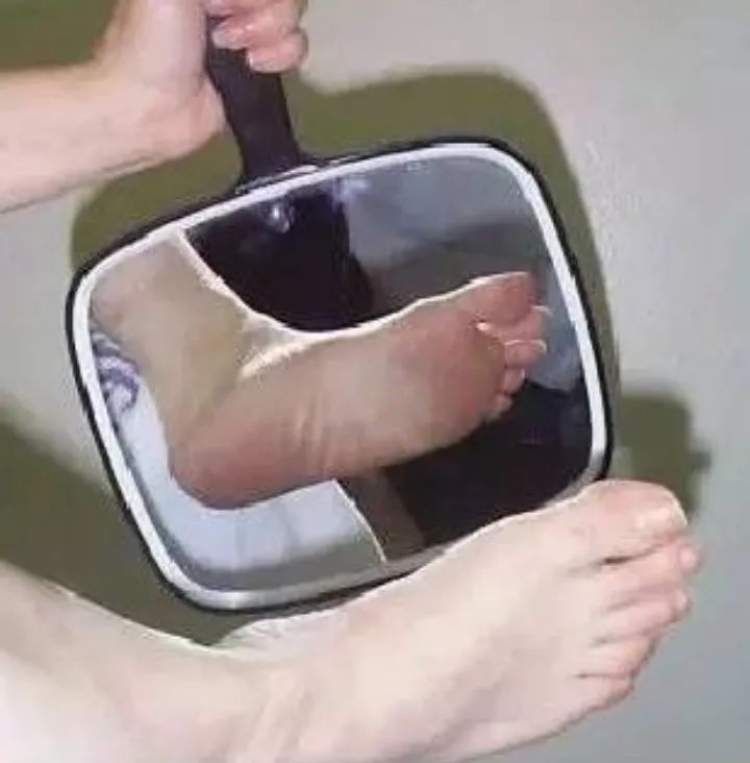
Self-examination method for diabetic patients
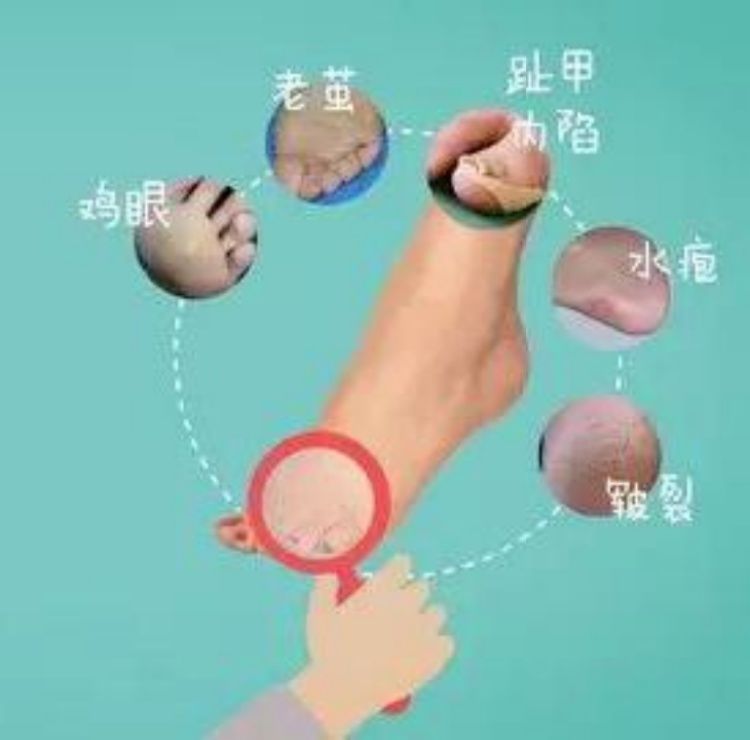
Contents of Self-Foot Examination for Diabetic Patients
3) Patients with calluses, corns, and foot deformities are prone to ulcers at friction sites and increased plantar pressure. Podiatrist treatment and management, and customized special decompression/orthopedic appliances, shoes or insoles under the guidance of a podiatrist. Severe foot deformities require a multidisciplinary team (endocrinology combined with orthopedic surgery).
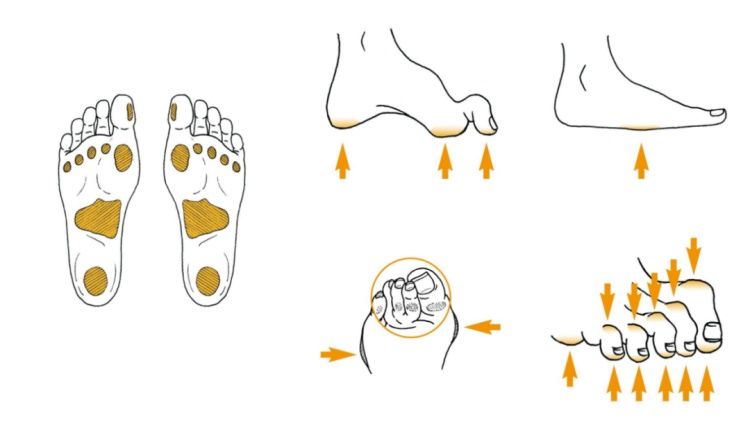
Sites prone to ulcers in foot deformities
What should be paid attention to in daily foot care for diabetic patients ?
1) Foot washing and foot skin care
Wash your feet with warm water (<37℃) every day, do not test the water temperature with your hands or feet, use a thermometer to measure the water temperature, soak in The time for the feet should not exceed 10 minutes, and it is not recommended to soak the feet for a long time. After washing, use a light-colored, soft, absorbent cotton towel to gently dry, and check for cracks, bleeding, and exudation, and keep your toes dry.
It is recommended to use a skin care cream or cream to keep the skin soft, massage the feet properly, and be careful not to apply the cream between the toes or on the ulcer wound. With chapped skin, you can use a special chapped cream containing urea.

Washing water temperature and time
2) Precautions for cutting toenails
< p> When cutting toenails, they should be cut flat after cleaning and drying, not too short or too close to the skin, do not tear or cut off the calluses or dead skin around the callus by yourself, avoid cutting too deep on both sides, and cut off the sharp parts; Don’t let your toenails grow too long; don’t go to a public bathroom for a pedicure; don’t use corn ointment to treat corns and calluses yourself; if there is a problem, go to a diabetes specialist or a professionally qualified diabetic foot clinic.
3) Wear suitable shoes and socks
Change clean, soft socks every day, choose light-colored cotton socks or wool socks that are absorbent and breathable, suitable in size, The cuffs should not be tight, the inner seams should be flat, not too rough, and not have holes.
Choose shoes that are the right size, with a wide toe that is breathable and deep, and conforms to the shape of the forefoot and toes, don’t wear shoes that have holes or are too tight; have a thick sole , low waist, sturdy rear with laces or velcro and smooth lining forClose the shoe sufficiently to prevent shearing injuries to the toes or the sole of the foot from sliding forward.
How to prevent diabetic foot?
1) Stay away from risk factors
(1) Do not smoke and avoid second-hand smoke.
(2) Don’t walk barefoot, especially don’t walk barefoot on hot sand or concrete, and don’t wear shoes with bare feet.
(3) Do not get too close to heat sources such as heaters and electric heaters, and do not use warm water bags, electric heating treasures, electric blankets, etc.
2) Blood sugar control, comprehensive management, and regular visits to the hospital for early screening of chronic diabetes complications
(1) Diabetics do not only need blood sugar (fasting blood sugar, postprandial blood sugar) , Glycated hemoglobin) up to the standard, less dynamic blood glucose fluctuations, but also up to the standard weight (obese people need to lose weight, thin people need to gain weight, they must strive to reach the standard weight), ensure adequate sleep, maintain a good mood, and at the same time blood lipids, blood pressure, isotype Cysteine, blood uric acid, etc. should also reach the standard.
(2) If you have symptoms of cold, numbness and pain in the lower extremities, you should consult an endocrinologist in time.
(3) Comprehensive screening for complications at least once a year; patients with type 1 diabetes with a course of more than 5 years should be comprehensively screened for complications every year, because of various chronic complications of diabetes in the early and middle stages can have no symptoms.
3) Seek medical attention in time
(1) Seek medical attention in time if you find blisters, tinea pedis, paronychia, corns, calluses, skin ulcers, etc. If you notice any redness, swelling, pus, localized discoloration (purple, blue, whitish), or excessive cold or heat, seek medical attention immediately, even if you do not feel pain.
(2) Develop the habit of foot care, and go to the hospital for professional inspection and evaluation every year, and the medical team will educate and manage the patients who are at risk of foot disease.
The title picture shows the recording scene of the program “Healthy You Dao”